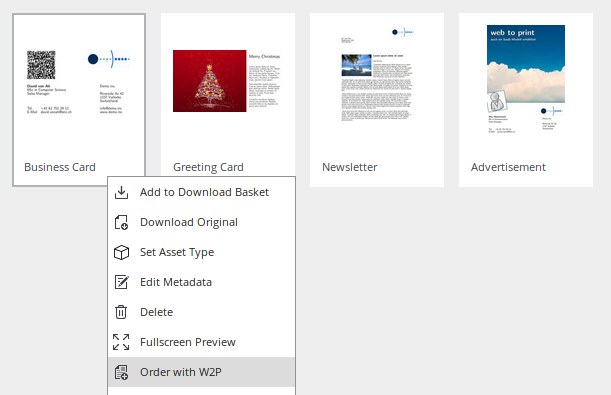brix:papilio Connect
Connects brix:papilio to CELUM, so that CELUM users can place orders in W2P without having to leave CELUM.
Check out https://vimeo.com/364313569 for a short introduction video.
Properties
To be configured in {home}/appserver/conf/custom.properties
papilio.baseUrl
type: String, required: yes, default: -
Where to find the papilio celum endpoint, e.g. http://papilio.company.com/integrations/celum
papilio.token
type: String, required: yes, default: -
The security token you've (had) configured in brix:papilio
papilio.userGroupIds
type: List of long , required: yes, default: -
A list of user group IDs who are allowed to use this plugin
papilio.templateNodeIds
type: List of long, required: yes, default: -
A list of NodeIDs where the template placeholders live. Adds a context menu entry where users can place new W2P orders. Note that all the contained assets should have metadata in their papilio.templateInfofieldId.

papilio.workspaceNodeId
type: long, required: yes, default: -
The NodeID of where to put the order placeholders and PDFs. This node will automatically be populated with subfolders named after the user that has created the orders - this user will be given the configured papilio.roleId on his node, as well as a subscription for the asset added and asset version added events.

papilio.assetType
type: long, required: yes, default: -
The AssetTypeID that should be assigned to ordered PDFs
papilio.orderInfofieldId
type: long, required: yes, default: -
In which information field the papilio order ID should be tracked
papilio.templateInfofieldId
type: , required: yes, default: -
In which information field the papilio template ID should be tracked
papilio.relationId
type: String, required: yes, default: -
Which relation to use to relate ordered PDFs to their templates
papilio.roleId
type: long, required: yes, default: -
Which role to assign on personal folders in the workspace
It's almost impossible to find out the ID of a role. The best way we've found is to go to
CMA > Roles > Export, download the XML, search for the role name and look at the<roles sourceID="1">tag one line above.
papilio.inheritedPermission
type: , required: no, default: -
Whether to turn on permission inheritance on said folders
GDPR-Feature
papilio.deleteOrdersOfTrashedAssets
type: , required: no, default: false
Turns on deletion of papilio orders when it's related to a CELUM asset that is deemed GDPR-relevant and that has been deleted in CELUM.
papilio.deleteOrdersOfTrashedAssets
type: , required: no, default: false
papilio.deleteOrdersOfTrashedAssetsNodeId
type: long, required: no, default: false
When to consider the assets "deleted" (i.e. a trash bin) - if not set, this uses the first node in trashbin.nodeType
papilio.deleteOrdersOfTrashedAssetsCondition
type: String, required: no, default: false
Optional additional condition whether to tell papilio to delete associated orders (e.g. "picture with a person on it") - uses the SearchUtil syntax, e.g. infofield=108,true
Compatibility Matrix
| papilioConnect | CELUM |
|---|---|
| 1.0 and above | 5.13.3 and above |
Release Notes
1.0
Released 2017-07-18
Initial version
1.1
Released 2018-06-26
Updated to the latest utils
1.2
Released 2019-06-17
Added GDPR feature
© brix Solutions AG
